Table of Contents
- Introduction
Case Studies
- Introduction
- Ed Roberts Campus
- Gallaudet University 6th Street Development
- Skyler
- Black Women Build
- New Swampscott High School and Senior Center
- Las Abuelitas Kinship Housing
- Side by Side
- Disability × Maternity: A Household User’s Manual for Young Mothers with Disability
- Carehaus
- 11th Street Bridge Park
- North Philly Peace Park
- Table Top Apartments
Aging Against the Machine
Block Party: From Independent Living to Disability Communalism
Decolonizing Suburbia
Re:Play Reclaiming the Commons through Play
About the Reading Room
Field Notes from the Future
Introduction
The manuscripts displayed in the exhibition, developed during an Iyapo Repository workshop led by Ayodamola Okuseinde, describe artifacts created to affirm and project the future of people of African descent. Taken together, they portray NYCHA as a self-sustaining oasis, tapping into community traditions of mutual aid, in a context of continued disinvestment, climate change, and food insecurity. The objects in the gallery space are 3D representations of the artifacts with audio narrated by their designers.
About Iyapo Repository
Iyapo Repository is a resource library that exists in a nondescript future that was founded to collect and preserve artifacts to ensure the history and legacy of people of African descent. In design futuring workshops, participants generate and build technological cultural artifacts of their future. The project is situated between physical and digital spaces, between the present and the future. It asks us to reimagine notions of race, identity, and culture through technological artifacts as they travel through time and place.
For Re:Play, Ayodamola Okuseinde focused on the future of NYCHA campuses as seen through the lens of utopias/dystopias, exploring reclamation around issues of heath, food, land, music, and safety. We are grateful for Ayo’s generosity in sharing their work in this exhibition.
Ayodamola Tanimowo Okunseinde, Co-Director of Iyapo Repository, is a Nigerian-American artist, designer, anthropologist, and time-traveler living and working in New York.
Manuscripts
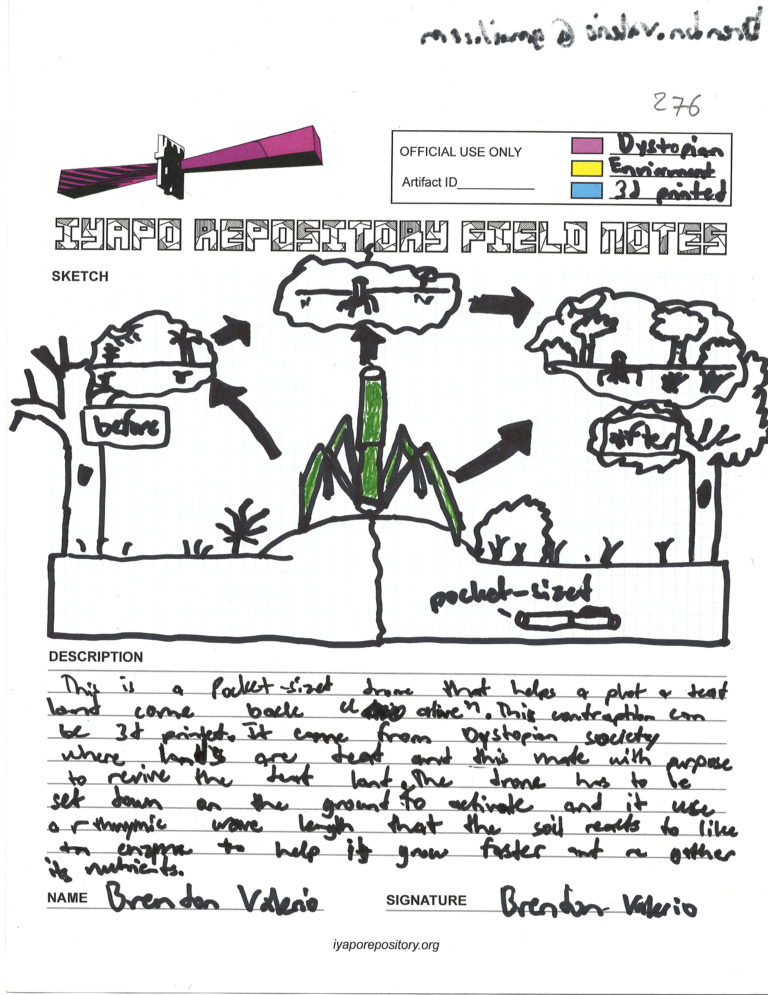
Environmental Remediation Drone
Author: Brendon Valerio
Visual Description:
A typed worksheet titled “IYAPO REPOSITORY FIELD NOTES” features a hand drawing in thick black ink of a green drone with before and after scenes of environmental regeneration and an accompanying explanatory text. The top register of the worksheet includes the Iyapo Repository’s logo, a black and white rectangular prism with two extruded magenta beams. To the right of the logo, a typed box that reads “OFFICIAL USE ONLY” includes space for an “Artifact ID.” In the same box, three text fields, each associated with a colored rectangle, are filled in with handwritten text that reads “Dystopian” (pink), “Environment” (yellow), and “3d printed” (blue). The worksheet’s middle register is a space for drawing and has a typed heading on the left side of the page that reads “SKETCH.” Here, a drawing of a green drone in thick black ink has been placed in the center of the page. To the left side of the drone is a “before” scene, showing a leafless tree and dried plants. To the right of the drone is an “after” scene, showing the same site with leafy trees and plants. Arrows connect three small clouds that show how the drone works to remediate the environment. The bottom-right side of the drawing features a sketch of the collapsed drone, with a label that reads “pocket-sized.” The bottom register includes a typed heading that reads “DESCRIPTION,” along with several horizontal lines that have been filled with handwritten text that reads: “This is a pocket-sized drone that helps a plot of dead land come back ‘alive.’ This contraption can be 3D printed. It came from Dystopian society where lands are dead and this made with purpose to revive the dead land. The drone has to be set down on the ground to activate and it uses a rhythmic wave length that the soil reacts to like an enzyme to help it grow faster and gather its nutrients.” The name and signature of the workshop participant, Brendon Valerio, appear below this description.
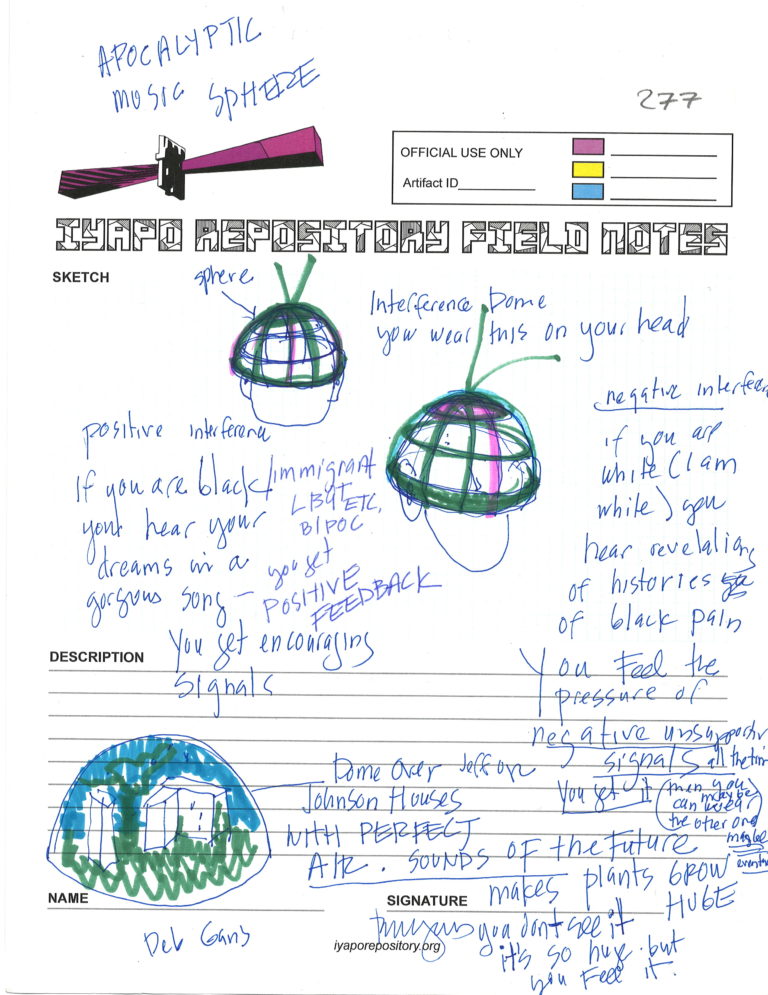
Apocolyptic Music Sphere
Author: Deborah Gans
Visual Description
A typed worksheet titled “IYAPO REPOSITORY FIELD NOTES” features hand drawings and hand-written explanatory texts in blue ink for an “apocalyptic music sphere” that provides positive feedback to BIPOCs and minorities and stories of injustice to white users. The top register of the worksheet includes the Iyapo Repository’s logo, a black and white rectangular prism with two extruded magenta beams. To the right of the logo, a typed box that reads “OFFICIAL USE ONLY” includes space for an “Artifact ID”. In the same box are three text fields, each associated with a colored rectangle (pink, yellow, and blue). The middle register has a typed heading that reads “SKETCH” and space for drawing, while the bottom register features lines to write handwritten text and a typed heading that reads “DESCRIPTION.” The participant has disregarded these sections and handwritten text and images are spread across the registers. At the top left corner of the worksheet, over the Iyapo Repository logo, is handwritten text in blue pen that reads “APOCALYPTIC MUSIC SPHERE.” At the center of the “SKETCH” section are two blue ink drawings of a spherical helmet with antennae placed over a figure’s head seen from two angles. The helmet drawings have been outlined with green and pink markers and are labeled “Interference Dome.” A note below this label reads, “You wear this on your head.” To the left of the sketches of the helmet, text reads, “Positive Interference / If you are black/immigrant/LGBT, BIPOC, etc. you hear your dreams in a gorgeous song—you get POSITIVE FEEDBACK. You get encouraging signals.” To the right of the helmet, text reads, “Negative interference / if you are white (I am white) you hear revealing histories of black pain. You feel the pressure of negative unsupportive signals all the time. You get it. (Then you can maybe wear the other one eventually).” At the bottom of the worksheet is a blue ink drawing of a dome that encloses buildings surrounded by blue sky and green space. To the right of the drawing, text reads, “Dome over Jefferson Johnson houses with PERFECT AIR. Sounds of the future make plants grow huge. You don’t see it it’s so huge but you feel it.” The name of the workshop participant, Deb Gans, appears below the sketches and handwritten text.
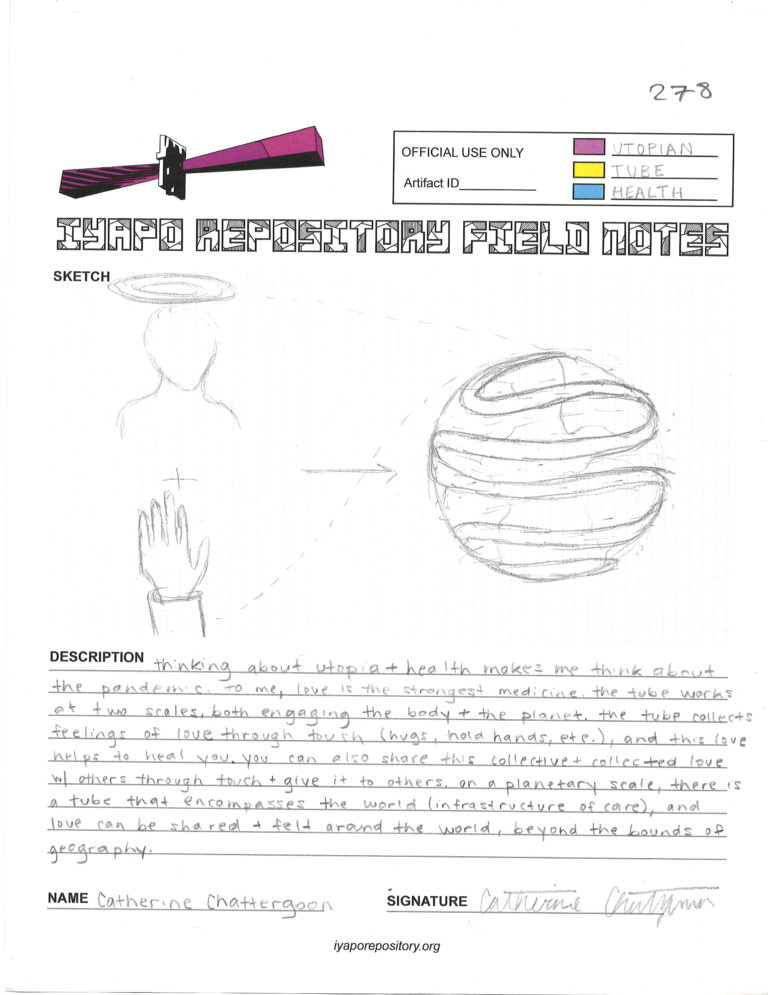
Utopian Health Tube
Author: Catherine Chattergoon
Visual Description
A typed worksheet titled “IYAPO REPOSITORY FIELD NOTES,” features pencil drawings of a person’s head and shoulders with a tube over their head, an open hand, and a tube wrapped around an orb, along with accompanying explanatory text. The top register of the worksheet includes the Iyapo Repository’s logo, a black and white rectangular prism with two extruded magenta beams. To the right of the logo, a typed box that reads “OFFICIAL USE ONLY” includes space for an “Artifact ID.” In the same box, three text fields, each associated with a colored rectangle, are filled in with handwritten text that reads “Utopian” (pink), “Tube” (yellow), and “Health” (blue). The worksheet’s middle register is a space for drawing and has a typed heading on the left side of the page that reads “SKETCH.” The left part of this register has a drawing of a person’s head and shoulders with a halo-like tube suspended over their head. A plus sign under this figure connects it to another drawing of an open hand. In the center, an arrow connects these two illustrations to a drawing of a sphere wrapped by a ribbon-like tube. The bottom register includes a typed heading that reads “DESCRIPTION,” along with several horizontal lines that have been filled with handwritten text that reads: “Thinking about utopia and health makes me think about the pandemic. To me, love is the strongest medicine. The tube works at two scales, both engaging the body and the planet. The tube collects feelings of love through touch (hugs, hold hands, etc.), and this love helps to heal you. You can also share this collective + collected love with others through touch and give it to others. On a planetary scale, there is a tube that encompasses the world (infrastructure of care), and love can be shared + felt around the world, beyond the bounds of geography.” The name and signature of the workshop participant, Catherine Chattergoon, appear below this description.
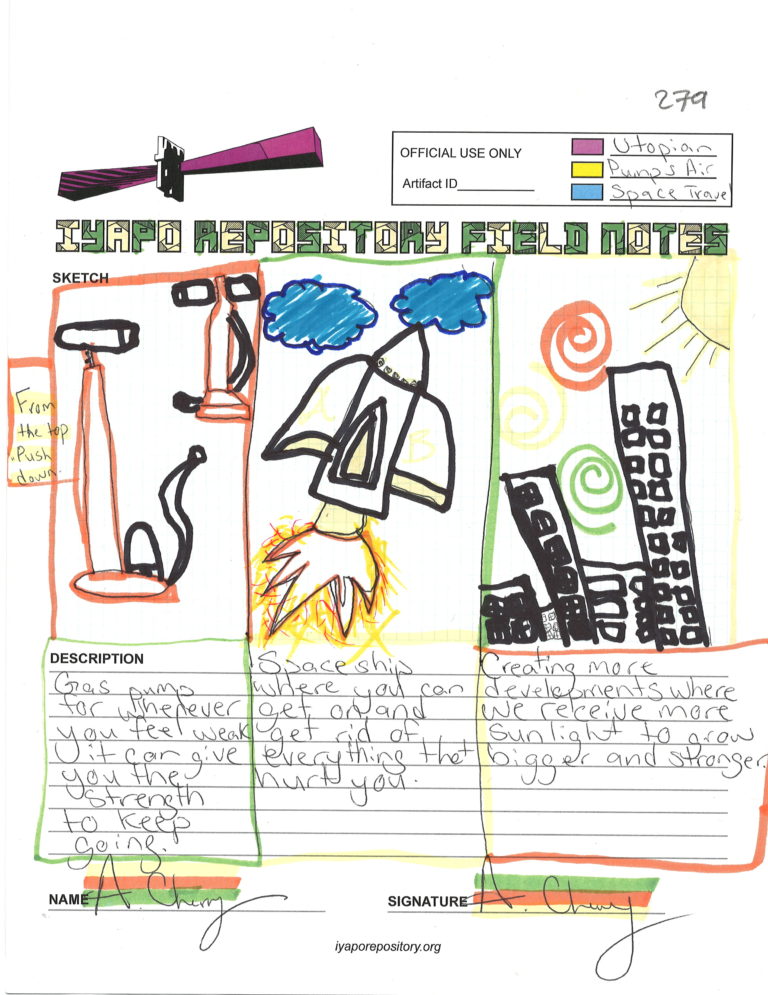
Reenergizing Gas Pump, a Spaceship, and New Housing Developments
Author: Aboubaker Cherry
Visual Description
A worksheet titled “IYAPO REPOSITORY FIELD NOTES” features colorful marker drawings of a pump, a spaceship, and housing developments, along with handwritten explanatory texts in black pen. The top register of the worksheet includes the Iyapo Repository’s logo, a black and white rectangular prism with two extruded magenta beams. To the right of the logo, a box that reads “OFFICIAL USE ONLY” includes space for an “Artifact ID.” In the same box, three text fields, each associated with a colored rectangle, are filled in with handwritten text that reads “Utopian” (pink), “Pumps Air” (yellow), and “Space Travel” (blue). The worksheet’s middle register is a space for drawing and has a typed heading on the left side of the page that reads “SKETCH,” while the the bottom register has horizontal lines below a heading that reads “DESCRIPTION.” Three vertical lines, two in orange marker and one in green marker, divide these registers into three image-and-text sections for three different inventions. On the left-hand-side is a pen drawing outlined in marker of an orange and black pump seen from two angles with a label that reads: “From the top push down.” The explanatory text below reads: “Gas pump for whenever you feel weak it can give you the strength to keep going.” In the center is a pen drawing outlined in marker of a spaceship blasting off and surrounded by two blue clouds. The explanatory text below reads: “Spaceship where you can get on and get rid of everything that hurt you.” On the right side is a pen and marker drawing of four buildings of different heights, with a yellow sun shining down on them from the top right-hand corner. Three spirals in orange, green, and yellow marker are drawn in the sky between the buildings. The explanatory text below the drawing reads, “Creating more developments where we receive more sunlight to grow bigger and stronger.” The name and signature of the workshop participant, A. Cherry, appear below this description.
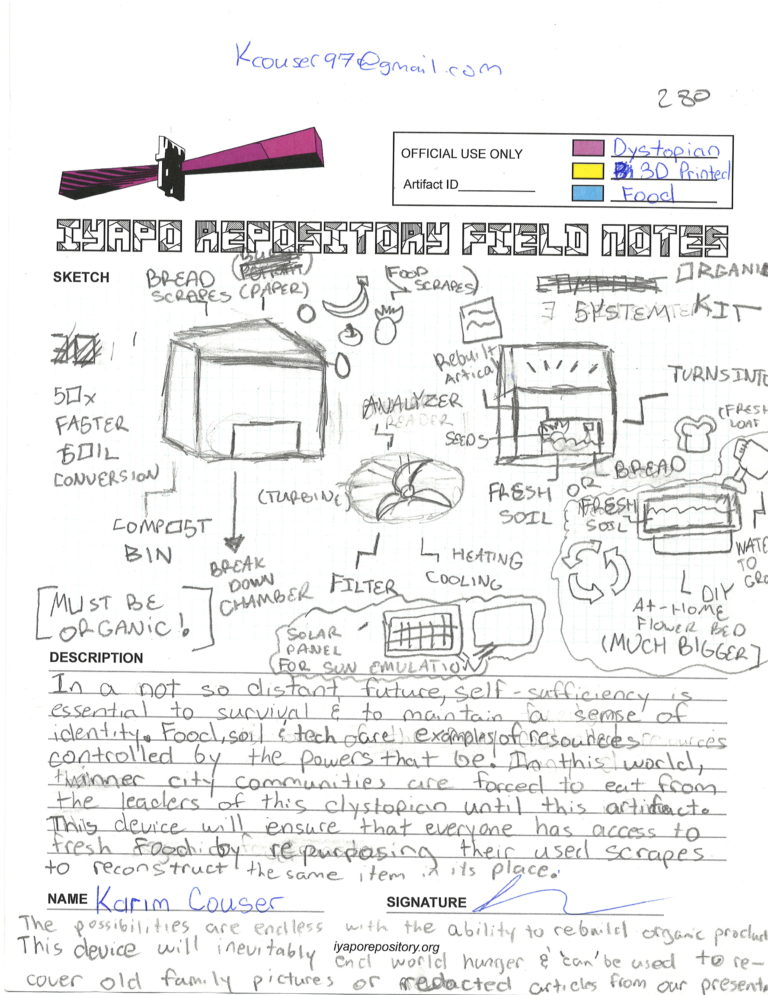
Organic System Kit
Author: Karim Couser
Visual Description
A typed worksheet titled “IYAPO REPOSITORY FIELD NOTES” features several pencil drawings and handwritten explanatory texts that illustrate how a device that reconstructs food from food scraps works. The top register of the worksheet includes the Iyapo Repository’s logo, a black and white rectangular prism with two extruded magenta beams. To the right of the logo, a box that reads “OFFICIAL USE ONLY” includes space for an “Artifact ID.” In the same box, three text fields, each associated with a colored rectangle, are filled in with handwritten text in blue pen that read “Dystopian” (pink), “3D Printed” (yellow), and “Food” (blue). The worksheet’s middle register is a space for drawing and has a typed heading on the left side of the page that reads “SKETCH.” This section includes several pencil drawings explaining how the invention works. A cubic object at the top left-hand corner is labeled “COMPOST BIN” and includes a note that reads “50x faster soil conversion.” Arrows and diagrams show different waste items—food scraps, papers, bread scraps—entering the device, where a “BREAK DOWN CHAMBER” processes the items. A drawing of a “TURBINE” in the center of this section explains what happens in the chamber through the following labels: “ANALYZER,” “HEATING,” “COOLING, “FILTER.” Below this, in a diagram that is sectioned off with a jagged line, the participant has depicted a solar panel “FOR SUN EMULATION,” hinting at how the machine is powered. On the right-hand side, the participant has once again drawn the cubic “ORGANIC SYSTEM KIT,” this time showing how the “REBUILT ARTICLE” has been reconstructed. The inner chamber of the machine is depicted with items inside of it, which are labeled “SEEDS” and “FRESH SOIL OR BREAD.” A sectioned off diagram on the bottom-left corner shows how the fresh soil and seeds created in the chamber are watered to grow a “DIY at-home flower bed.” The bottom register includes a typed heading that reads “DESCRIPTION,” along with several typed horizontal lines that have been filled with handwritten text that reads: “In a not so distance future, self-sufficiency is essential to survival and to maintain a sense of identity. Food, soil, and tech are examples of resources controlled by the powers that be! In this world, inner city communities are forced to eat from the leaders of this dystopian until this artifact. This device will ensure that everyone has access to fresh food by repurposing their used scrapes to reconstruct the same item in its place. The possibilities are endless with the ability to rebuild organic product. This device will inevitably end world hunger and can be used to recover old family pictures or redacted articles from our present.” The name and signature of the workshop participant, Karim Couser, appear below this description.
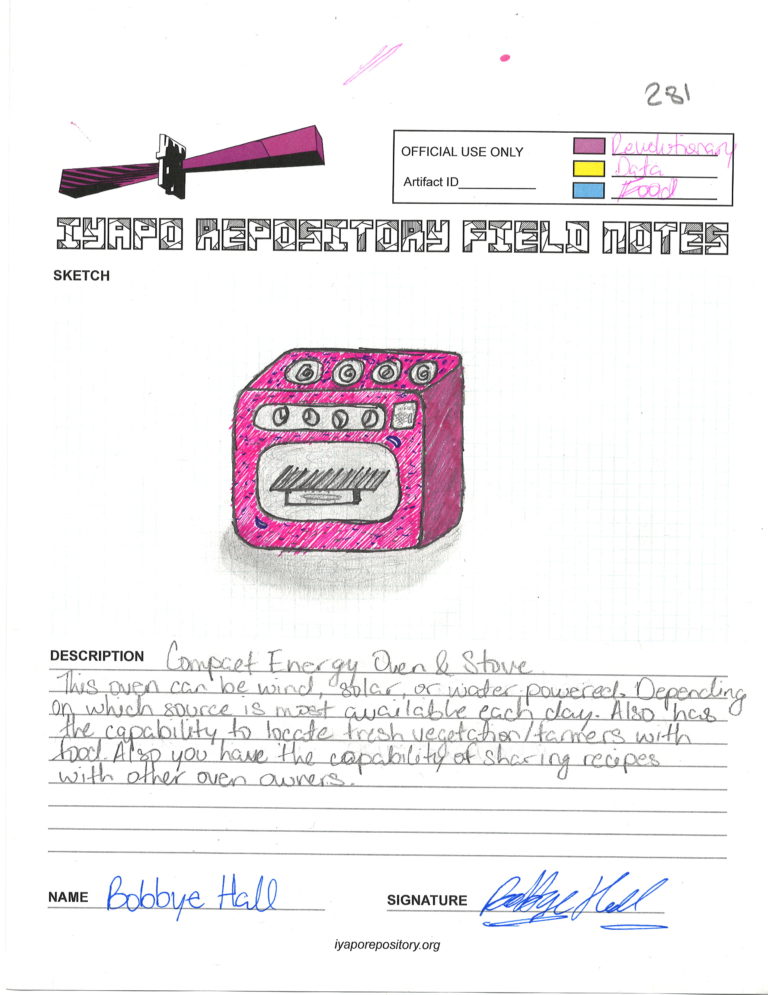
Compact Energy Oven and Stove
Author: Bobbye Hall
Visual Description
A typed worksheet titled “IYAPO REPOSITORY FIELD NOTES,” features a pen drawing of a pink oven, along with an accompanying handwritten description. The top register of the worksheet includes the Iyapo Repository’s logo, a black and white rectangular prism with two extruded magenta beams. To the right of the logo, a box that reads “OFFICIAL USE ONLY” includes space for an “Artifact ID.” In the same box, three text fields, each associated with a colored rectangle, are filled in with handwritten text that reads “Revolutionary” (pink), “Data” (yellow), and “Food” (blue). The worksheet’s middle register is a space for drawing and has a typed heading on the left side of the page that reads “SKETCH.” This register includes a hand-drawn pen illustration of a hot pink oven with four stove-top burners. Four knobs are located over the oven window. The bottom register includes a typed heading that reads “DESCRIPTION,” along with several typed horizontal lines that have been filled with handwritten text that reads: “This oven can be wind, solar, or water powered. Depending on which source is most available each day. Also has the capability to locate fresh vegetation/farmers with food. Also you have the capability of sharing recipes with other oven owners.” The name and signature of the workshop participant, Bobbye Hall, appear below this description.
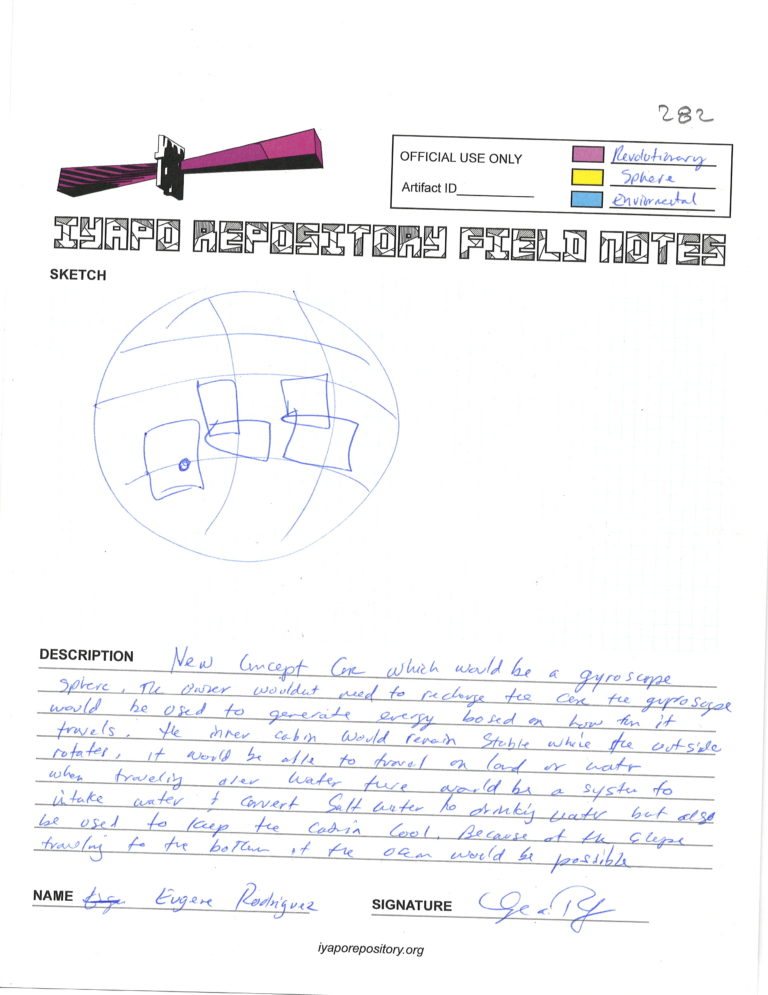
Gyroscope Sphere Car
Author: Eugene Rodriguez
Visual Description
A typed worksheet titled “IYAPO REPOSITORY FIELD NOTES” features a blue pen drawing of a segmented sphere, along with handwritten explanatory texts. The top register of the worksheet includes the Iyapo Repository’s logo, a black and white rectangular prism with two extruded magenta beams. To the right of the logo, a box that reads “OFFICIAL USE ONLY” includes space for an “Artifact ID.” In the same box, three text fields, each associated with a colored rectangle, have been filled in with handwritten text that reads “Revolutionary” (pink), “Sphere” (yellow), and “Environmental” (blue). The worksheet’s middle register is a space for drawing and has a typed heading on the left side of the page that reads “SKETCH.” At the center of this register is a hand-drawn blue pen sketch of a segmented sphere with five overlapping rectangular shapes inside. The bottom register includes a typed heading that reads “DESCRIPTION,” along with several typed horizontal lines that have been filled with handwritten text that reads: “New concept car which would be a gyroscope sphere. The owner wouldn’t need to recharge the car the gyroscope would be used to generate energy based on how far it travels. The inner cabin would remain stable while the outside rotates. It would be able to travel on land or water. When travelling over water there would be a system to intake water & convert salt water to drinking water but also be used to keep the cabin cool. Because of the ellipse traveling to the bottom of the ocean would be possible.” The name and signature of the workshop participant, Eugene Rodriguez, appear below this description.

Multipurpose Rooftop Oasis
Author: Eugene Rodriguez
Visual Description
A typed worksheet titled “IYAPO REPOSITORY FIELD NOTES” features pen and marker drawings and explanatory texts for a rooftop oasis located on top of a NYCHA housing project. The top register of the sheet includes the Iyapo Repository’s logo, a black and white rectangular prism with two extruded magenta beams. To the right of the logo, a typed box that reads “OFFICIAL USE ONLY” includes space for an “Artifact ID.” In the same box, three text fields, each associated with a colored rectangle, are filled in with handwritten text that reads “Revolutionary” (pink), “Makes Sounds” (yellow), and “Environment” (blue). The worksheet’s middle register is a space for drawing and has a typed heading on the left side of the page that reads “SKETCH.” In the center of this space is a blue pen bird’s-eye-view drawing of three towers that are connected via arched bridges. The roof of the building farthest to the left is labeled “Edible garden” and has drawing of tall fruit trees. The roof of the building in the middle is labeled “playground” and has drawings of playground structures surrounded by small bushes. The third rooftop is unlabeled but features a hemispherical platform surrounded by small green bushes. The bridges that connect the roofs feature purple and red wind turbines, while orange rectangles placed throughout the buildings and the bridges are labeled “solar panels.” Below the drawing of the NYCHA buildings is a drawing of a cylindrical element, with a label that reads “Air Chute to travel to the Roof & Back down to the ground.” The bottom register includes a typed heading that reads “DESCRIPTION,” along with several typed horizontal lines that have been filled with handwritten text that reads: “Creation of a multipurpose rooftop oasis in NYCHA. Roofs would be connected by glass bridges. Each bridge would be layered with solar panels to generate electricity also each bridge would have wind turbines to catch wind to create power as well as having embedded wind turbines on the bases of the bridges. Roofs would be rooftop edible gardens, rooftop playgrounds and a rooftop amphitheater for performances. Speakers on each roof would broadcast performances from the performance space and also have digital display boards to broadcast performances and or special effects in the development. Air shoots would run from ground level to the rooftops for access instead of going into the buildings. Each building would also have solar panels in between the windows on all four sides.” The name and signature of the workshop participant, Eugene Rodriguez, appear below this description.